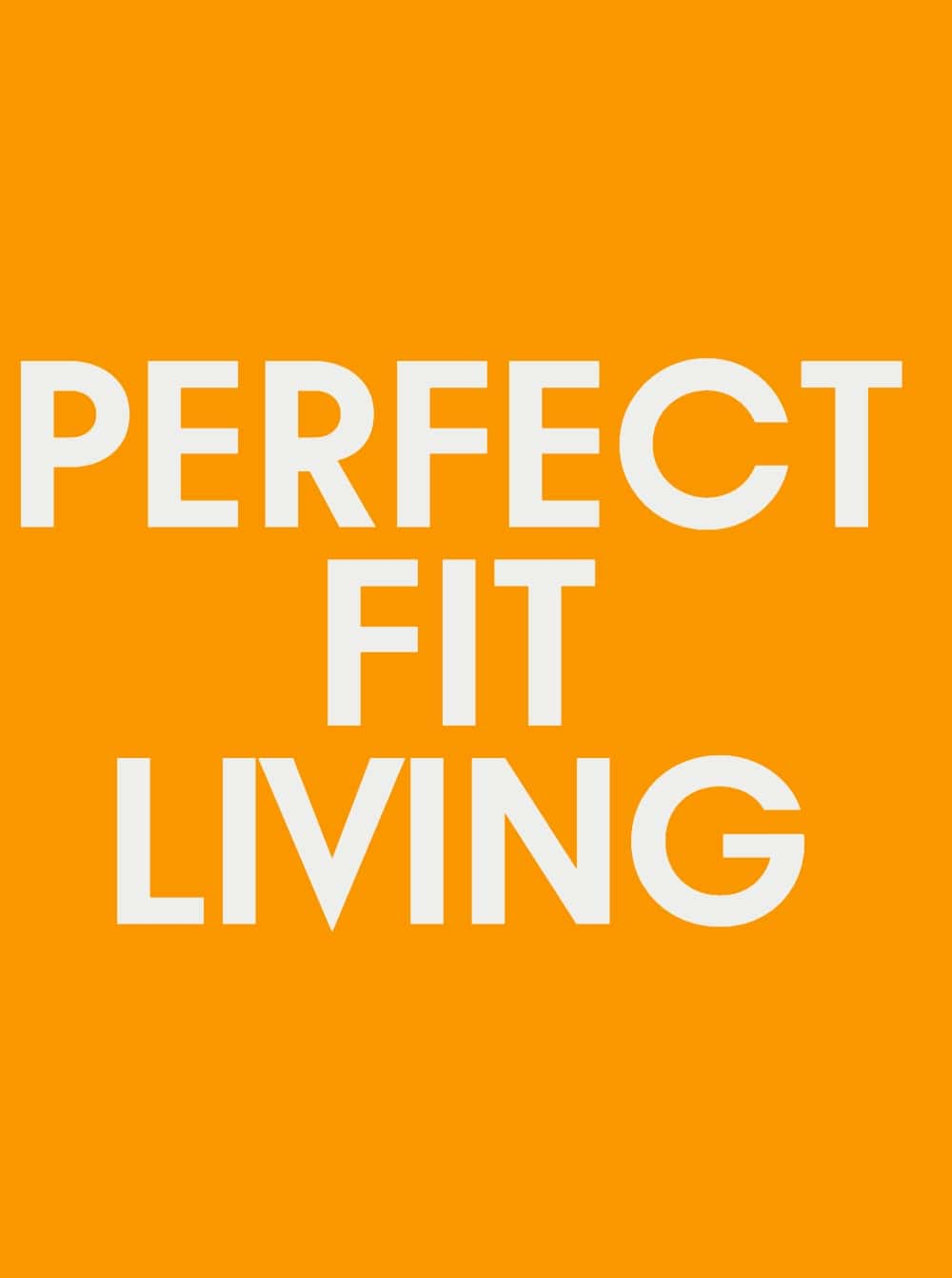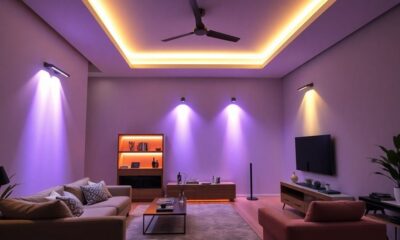Mattress Pads
Do You Put a Fitted Sheet Over a Mattress Pad
Transform your sleep experience by discovering the secret to a secure and cozy bed setup.
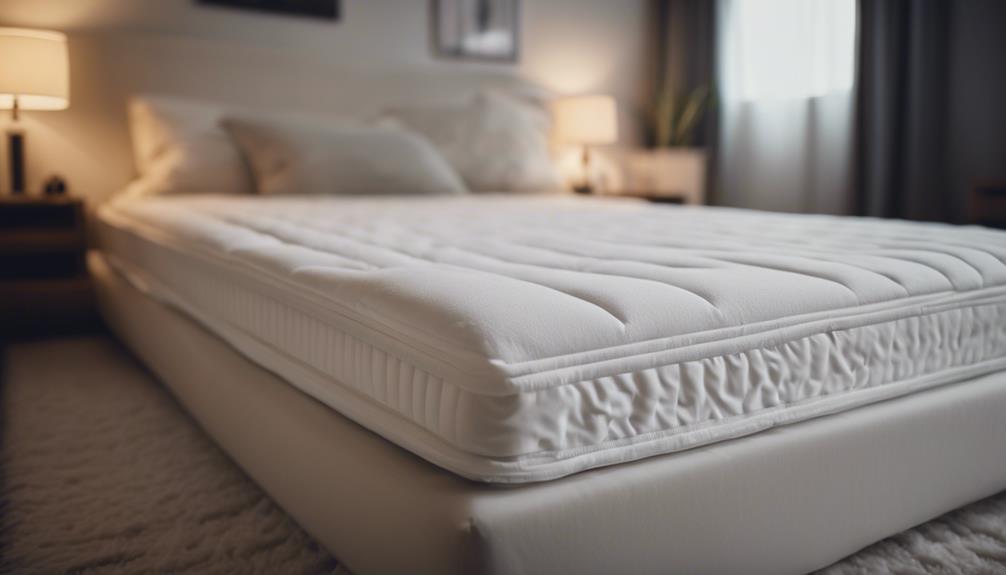
Placing a fitted sheet over a mattress pad ensures a snug and comfortable sleep surface, providing both support and cushioning for a restful night’s sleep. Not only does this extra layer safeguard the mattress pad, but it also extends its lifespan and elevates the appearance of your bed. By tucking the corners under the pad, you create a smooth and secure foundation that prevents any shifting or bunching, ultimately promoting a disturbance-free sleep. To uphold cleanliness, be sure to wash your fitted sheet regularly and opt for deep pocket sheets for a more secure fit. Prioritizing hygiene and comfort by selecting the appropriate materials will enhance your overall sleep quality. Follow these easy steps to enhance your sleeping experience.
Key Takeaways
- Yes, a fitted sheet goes over a mattress pad for added comfort and protection.
- Fitted sheets secure the mattress pad, prevent shifting, and enhance sleeping surface.
- Layering a fitted sheet over a mattress pad prolongs mattress life and maintains cleanliness.
- Choosing the right size fitted sheet ensures a snug fit for optimal benefits.
- Regularly washing fitted sheets and maintaining the mattress pad promote a hygienic sleep environment.
Importance of Using Fitted Sheet Over Mattress Pad
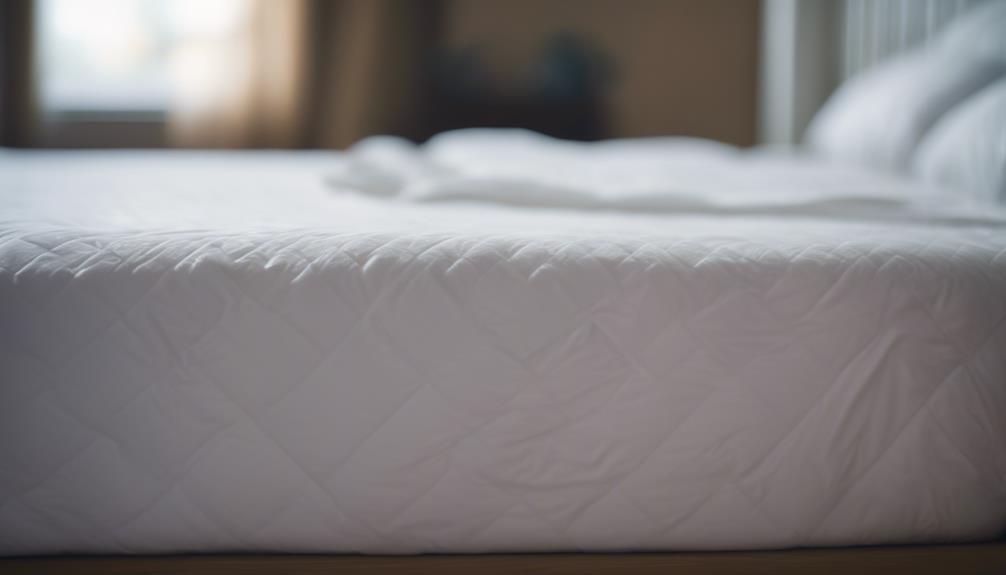
Using a fitted sheet over a mattress pad guarantees a secure and comfortable sleeping surface by preventing shifting or bunching. The fitted sheet acts as a protective barrier, keeping the mattress pad in place throughout the night. By securing the pad with the fitted sheet, you create a smoother and more stable foundation for a restful sleep experience. This added layer not only enhances comfort but also extends the lifespan of the mattress pad by reducing wear and tear caused by movement.
Furthermore, the fitted sheet not only offers practical benefits but also contributes to the overall aesthetics of the bed. It maintains a neat and tidy appearance for your bedding ensemble, giving a polished look to your sleeping area. By ensuring that the mattress pad stays in place, the fitted sheet helps to create a cohesive and inviting environment in your bedroom. So, beyond just importance, the fitted sheet plays a significant role in elevating the visual appeal of your sleeping space.
Benefits of Layering Mattress Pad With Fitted Sheet

Layering a mattress pad with a fitted sheet enhances the comfort of your bed, providing a plush surface for a cozy night's sleep. This combination not only improves the overall sleeping experience but also adds a layer of protection to your mattress, safeguarding it against spills and wear.
Additionally, the ease of removing and washing fitted sheets makes cleaning maintenance a breeze, ensuring a clean and hygienic sleeping environment for us.
Enhanced Comfort Layering
To enhance comfort when sleeping, consider adding a fitted sheet over a mattress pad for an extra layer of softness and cushioning. This combination provides a luxurious feel and a supportive base for a restful night's sleep. The fitted sheet helps keep the mattress pad in place, guaranteeing a smooth surface that stays put throughout the night. By layering these two bedding essentials, you not only increase comfort but also extend the lifespan of your mattress and pad by adding an extra protective barrier. This enhanced comfort layering creates a cozy and inviting bed environment, making bedtime a more enjoyable experience overall.
| Benefits of Enhanced Comfort Layering |
|---|
| – Increased softness and cushioning |
| – Secure placement during sleep |
| – Prolongs mattress pad and mattress life |
| – Ensures smooth and seamless surface |
| – Enhances overall sleep quality |
Improved Mattress Protection
How does adding a fitted sheet over a mattress pad enhance the protection and longevity of your bedding?
Layering a fitted sheet over a mattress pad offers multiple benefits. It provides an extra barrier against spills, stains, and general wear, safeguarding both the mattress pad and the mattress itself. By keeping the mattress pad securely in place, the fitted sheet prevents shifting during sleep, ensuring a comfortable and undisturbed rest.
This protective layer not only prolongs the life of your bedding but also improves hygiene by creating an additional shield between you and the mattress pad. The fitted sheet maintains a soft and cozy surface for sleeping while preserving the functionality of the mattress pad.
This simple addition can make a significant difference in the overall maintenance and durability of your bedding.
Easy Cleaning Maintenance
When we cover our mattress pad with a fitted sheet, maintaining cleanliness becomes effortless. The fitted sheet acts as a protective barrier, shielding the mattress pad from spills, stains, and dirt. This simple layering technique not only extends the lifespan of your mattress pad but also simplifies cleaning maintenance. With the ability to easily remove and wash the fitted sheet, keeping your bedding fresh and hygienic is a breeze. Let's take a look at how layering a fitted sheet over a mattress pad enhances the overall cleaning maintenance process:
| Benefits of Layering Mattress Pad With Fitted Sheet |
|---|
| Protects mattress pad from spills and stains |
| Simplifies cleaning maintenance |
| Adds extra comfort and cushioning to bedding |
Proper Arrangement of Fitted Sheet and Mattress Pad
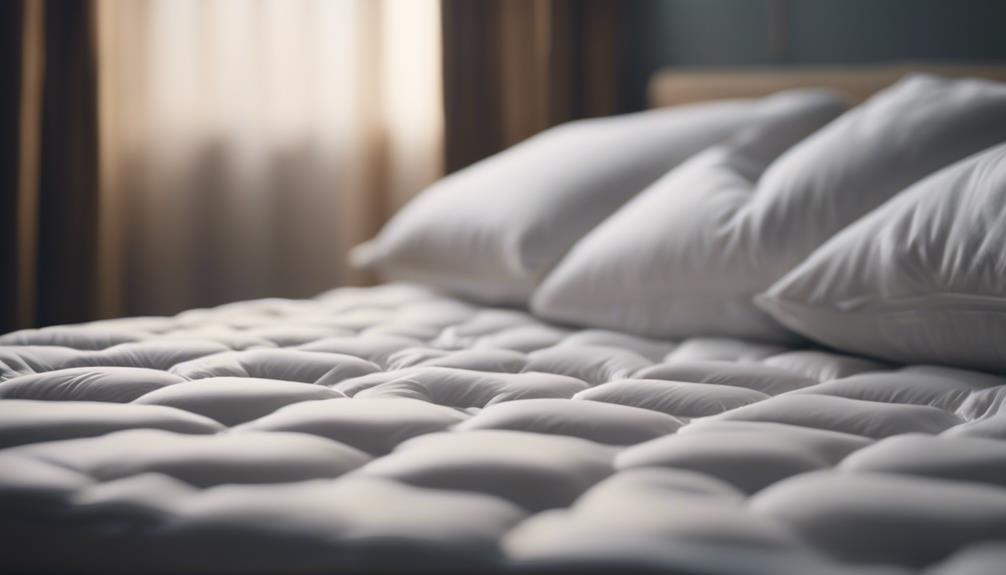
When arranging a fitted sheet over a mattress pad, it's crucial to layer for comfort and secure for a better fit.
Tucking the corners of the fitted sheet under the mattress pad guarantees a snug and smooth surface for sleeping.
This proper arrangement not only prevents shifting during the night but also enhances the overall quality of rest.
Layering for Comfort
Layering a fitted sheet over a mattress pad guarantees a snug and comfortable sleeping surface. This combination not only provides an extra layer of softness but also helps in safeguarding the mattress pad.
By placing the fitted sheet over the pad, you create a smooth and uniform feel to lie on. The fitted sheet acts as a shield, preventing the pad from moving around or becoming uneven during the night. This ensures a more restful sleep experience as you won't be disturbed by any shifting underneath you.
The proper arrangement of these bedding essentials enhances overall comfort, making your bed a cozy haven to retreat to after a long day.
Securing for Better Fit
To achieve a snug fit and guarantee a comfortable surface, properly securing a fitted sheet over a mattress pad is essential. When the fitted sheet isn't secured adequately, it can lead to shifting and bunching during the night, causing discomfort and disrupting sleep.
Ensuring that the corners of the sheet are tightly tucked under the mattress pad not only prevents shifting but also maintains a neat and tidy appearance. By securing the fitted sheet over the mattress pad, you create a smooth and protective barrier that enhances the overall aesthetics and functionality of your bedding.
This simple step not only improves the look of your bed but also contributes to a more restful and undisturbed night's sleep.
Enhancing Comfort With Fitted Sheet and Mattress Pad
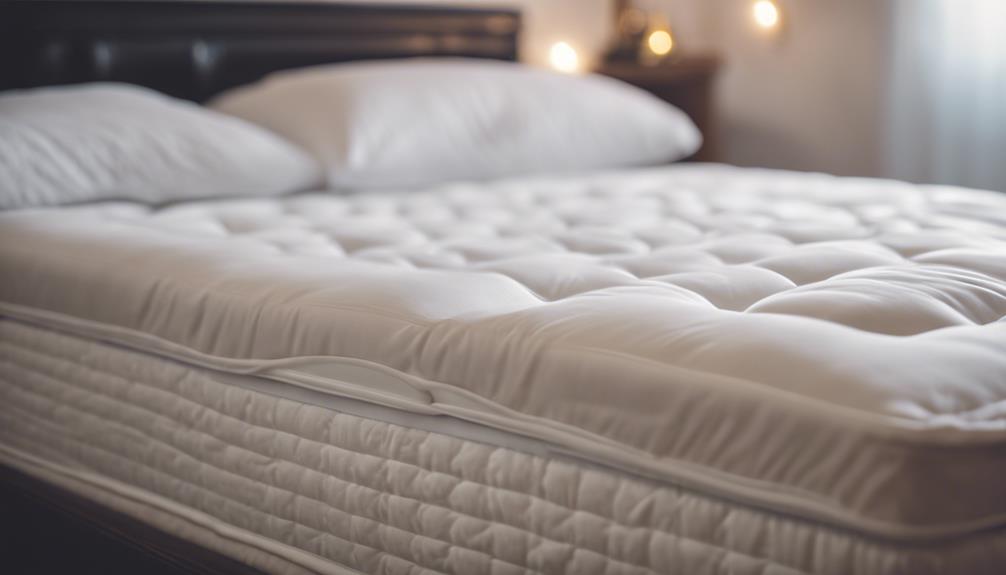
Enhancing our comfort with a fitted sheet and mattress pad involves creating a secure and smooth layer for a restful sleep experience. The fitted sheet serves as an essential element in ensuring the mattress pad stays in place, offering an added level of comfort and protection. By using a fitted sheet over the mattress pad, we not only prevent shifting or bunching but also improve the overall feel of our sleeping surface. This combination results in a cozy and secure setup that can greatly enhance the quality of our rest.
Choosing the right size fitted sheet and securely tucking it around the mattress pad can optimize these benefits. This simple step not only keeps everything in place but also adds a luxurious feel to our bed. The fitted sheet acts as a barrier, preventing the pad from moving around and ensuring a smooth, comfortable surface for a peaceful night's sleep.
Tips for Maintaining Mattress Cleanliness
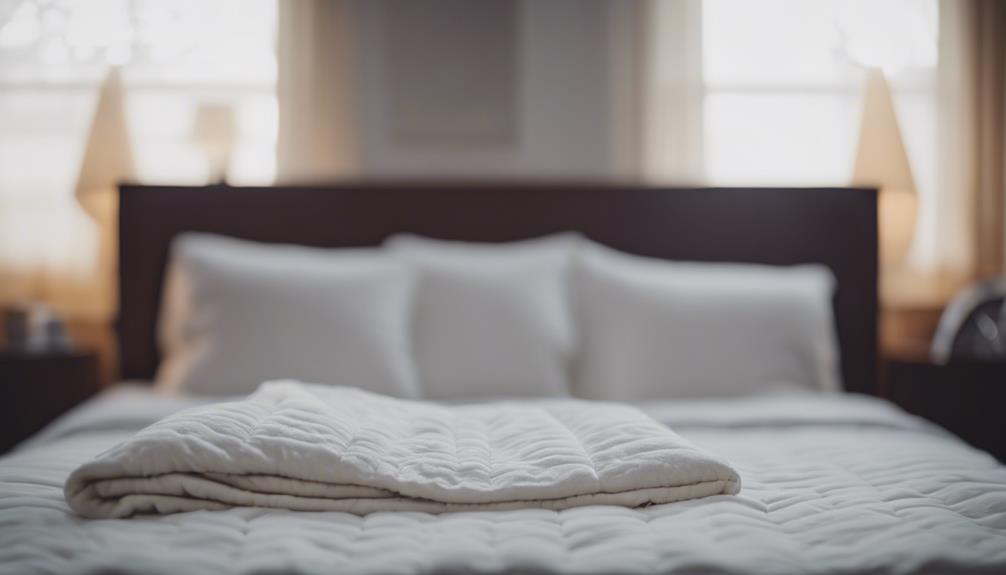
Maintaining mattress cleanliness is essential for ensuring a healthy and comfortable sleeping environment.
To keep your mattress fresh and hygienic, it's important to regularly wash your fitted sheet to prevent dust, dirt, and allergens from accumulating on the mattress pad.
The mattress pad itself serves as a protective barrier against spills, stains, and wear and tear, extending the life of your mattress.
When choosing a fitted sheet, opt for one with deep pockets to accommodate the height of the mattress pad securely.
Efficiency in Changing Bedding With Fitted Sheet and Mattress Pad
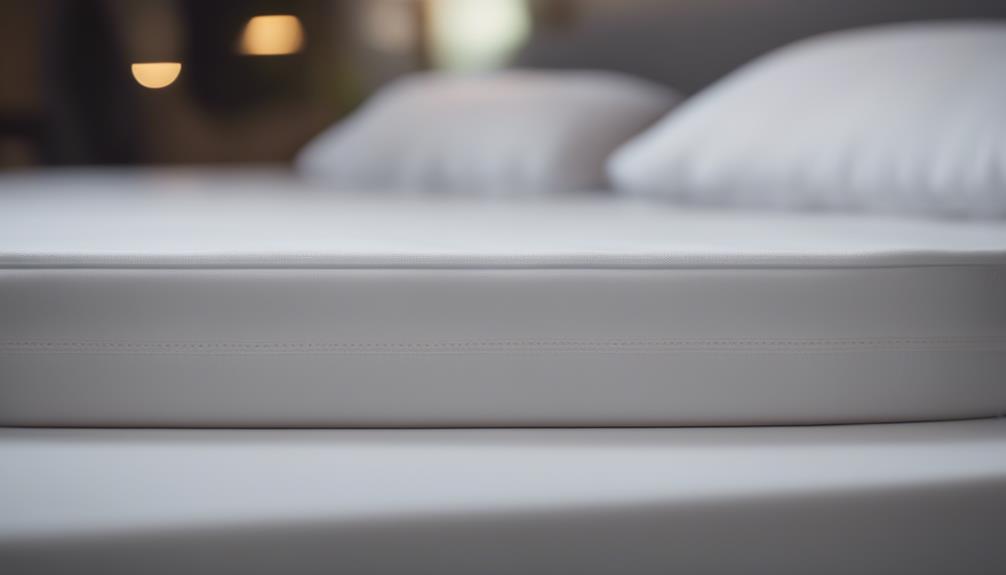
How can we streamline the process of changing bedding with a fitted sheet and mattress pad? Incorporating a fitted sheet over a mattress pad not only enhances comfort but also provides an extra layer of protection for your bed.
When it comes to efficiency, this bedding setup offers a practical solution. The fitted sheet helps secure the mattress pad in place, preventing it from shifting during sleep and ensuring a snug fit. This makes changing bedding a breeze, maintaining a clean sleeping environment effortlessly.
The combination of a fitted sheet and mattress pad not only adds to the overall comfort of your bed but also prolongs the life of your mattress by providing an additional layer of protection. The fitted sheet acts as a barrier between the sleeper and the mattress pad, promoting hygiene and cleanliness.
With this setup, you can enjoy the benefits of both comfort and convenience, making your bedding routine efficient and effective.
Ensuring Baby's Sleep Comfort With Fitted Sheet and Mattress Pad

To guarantee your baby's sleep comfort, we recommend using a fitted sheet over a mattress pad for a secure and cozy sleeping surface. By combining these two essential bedding layers, you make sure that your baby sleeps soundly and safely throughout the night. The fitted sheet plays an important role in providing a smooth and snug surface for your little one to rest on, while the mattress pad underneath offers an extra layer of comfort and protection. This combination not only enhances the overall sleeping experience but also prevents the mattress pad from shifting or bunching up, maintaining a consistent and secure placement for your baby.
When selecting a fitted sheet for your baby's mattress pad, make sure it's the right size to cover both the pad and mattress entirely. This ensures a proper fit and minimizes any potential risks associated with loose bedding. By prioritizing your baby's comfort and safety with a fitted sheet and mattress pad, you create a cozy and secure sleep environment that promotes restful nights and peaceful mornings.
Considerations for Choosing Fitted Sheets for Mattress Pads
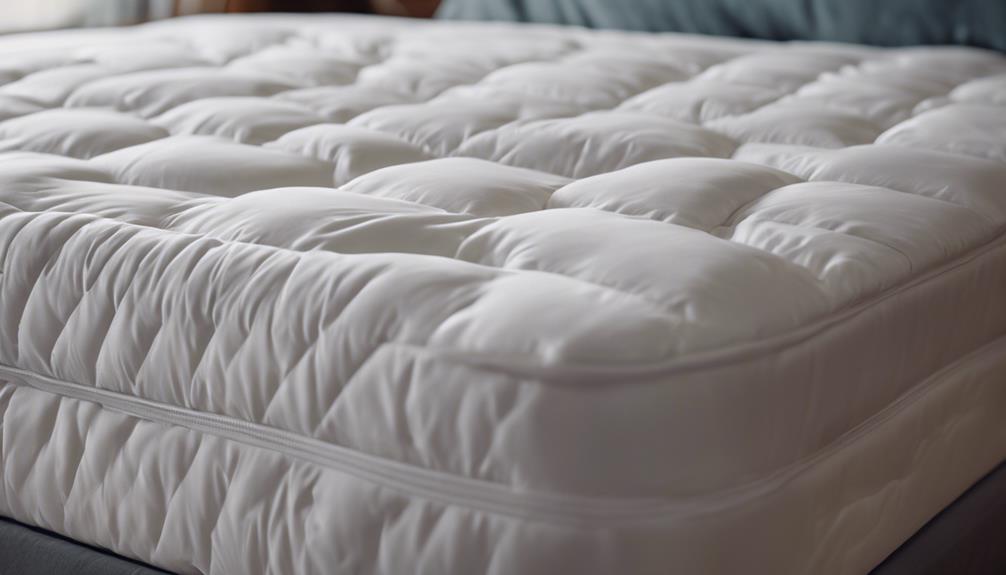
Considering the right fitted sheet for your mattress pad involves selecting deep pocket sheets that can accommodate the added height of the pad. Deep pocket sheets are crucial to guarantee a snug fit over both the mattress and the mattress pad.
Look for fitted sheets with elastic all around to secure them in place, preventing any shifting or bunching up. The elastic ensures a smooth and comfortable surface for a restful night's sleep.
When choosing a fitted sheet, also consider the material for breathability and comfort, especially when paired with a mattress pad. Opt for sheets that are easy to remove and wash to maintain cleanliness and hygiene with the mattress pad.
Frequently Asked Questions
Does a Mattress Pad Go Under a Fitted Sheet?
Yes, a mattress pad should go under a fitted sheet to enhance comfort and protect the mattress. Placing the mattress pad beneath the fitted sheet keeps it secure and prevents shifting while you sleep.
The fitted sheet is designed to cover both the mattress and the mattress pad for a snug fit. This arrangement guarantees cleanliness and helps extend the lifespan of the mattress pad.
It also adds an extra layer of comfort and hygiene for a restful night's sleep.
Do I Need a Bigger Fitted Sheet With a Mattress Topper?
When adding a mattress topper, opting for a deeper pocket fitted sheet is crucial for a secure fit. Regular sheets might slip off, so choosing a larger size guarantees everything stays snug.
Deep pocket sheets are made to handle thicker mattresses or toppers. By properly fitting sheets over a topper, we prevent shifting and create a comfy sleep oasis.
It's all about that perfect fit for a restful night's sleep!
Do You Put a Mattress Protector Under a Sheet?
When it comes to ensuring a clean and comfortable sleep surface, placing a mattress protector under a sheet is a smart move. The protector acts as a shield against spills, dust, and allergens, extending the life of your mattress.
Should You Put Something Under a Fitted Sheet?
Placing something under a fitted sheet can enhance comfort and mattress protection.
One interesting statistic to note is that using a mattress pad under a fitted sheet can increase the lifespan of your mattress by up to 10 years.
It's a simple way to add extra cushioning, prevent spills, dust, and wear.
We highly recommend this practice for a cozy, clean, and well-maintained bed.
Conclusion
To sum up, it's crucial to use a fitted sheet over a mattress pad for maximum comfort and cleanliness. By layering these two bedding essentials, you can improve the quality of your sleep and easily maintain hygiene.
Remember, as the saying goes, 'a stitch in time saves nine,' so take the time to properly arrange your fitted sheet and mattress pad for a cozy and inviting bed. Your body will thank you for it!
Mattress Pads
Can You Use a Heated Mattress Pad on a Nectar Mattress
Marvel at the possibility of using a heated mattress pad on your Nectar mattress for enhanced comfort and warmth, with vital tips for optimal usage.
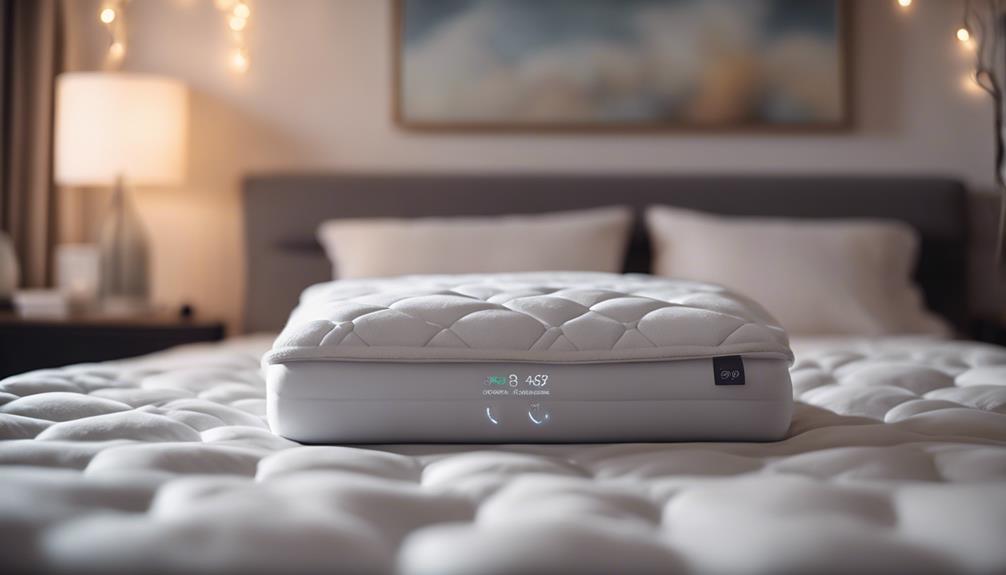
Yes, it is safe to use a heated mattress pad on a Nectar mattress, but it is crucial to adhere to safety guidelines. It is recommended to select low heat settings to avoid damaging the memory foam. While electric blankets can provide added warmth, they need adequate ventilation and supervision. The safety features on heated pads help prevent overheating, which in turn helps prolong the mattress’s lifespan. Enjoy advantages such as customizable warmth for muscle relaxation and improved sleep quality. To enhance your experience, ensure the pad is evenly placed for ventilation and clean it regularly. Make safety and comfort a priority to maximize the benefits of using a heated pad on your Nectar mattress. Discover more tips on how to optimize your sleep experience.
Key Takeaways
- Heated mattress pads can be used on Nectar mattresses for added warmth.
- Follow safety guidelines to prevent damage to memory foam.
- Use low heat settings and proper ventilation with electric blankets.
- Ensure even placement for efficient heating and comfort.
- Maintenance and care are essential for prolonging pad and mattress lifespan.
Safety Guidelines for Heated Mattress Pads on Nectar Mattresses
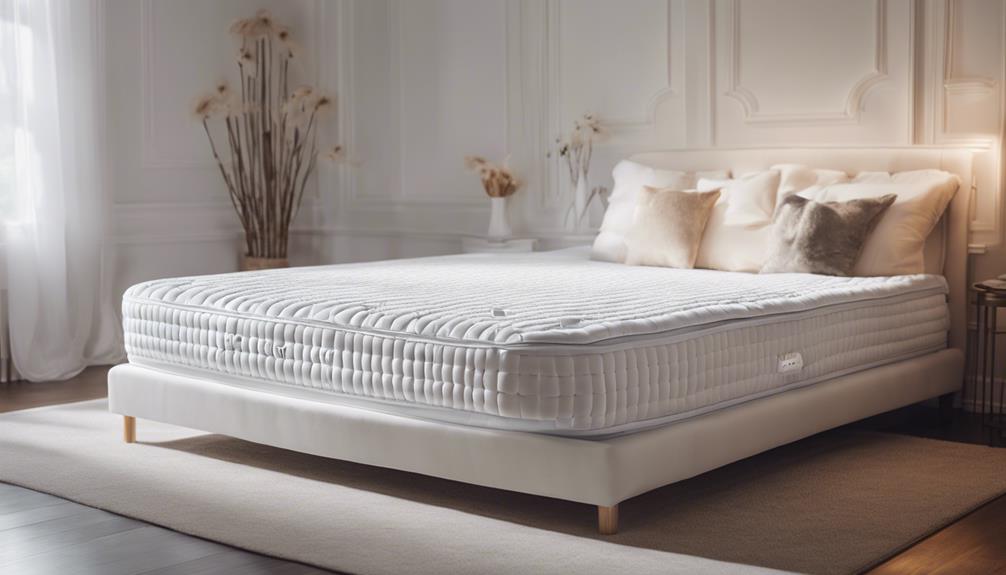
When considering the use of heated mattress pads on Nectar mattresses, it's important to prioritize safety guidelines to prevent potential damage. Memory foam, the material used in Nectar mattresses, can be sensitive to excessive heat. Electric blankets or heated mattress pads that emit high levels of heat can degrade the memory foam over time. Direct heat application may cause the foam material to break down prematurely, leading to a loss of support and comfort. Additionally, factors like sweat and skin oils combined with heat can further contribute to damaging the memory foam.
To guarantee the longevity and performance of your Nectar mattress, it's advisable to follow safety tips when using heated mattress pads. Opt for low heat settings to minimize the risk of heat-related damage to the memory foam. Consider using a mattress protector to create a barrier between the heated pad and the mattress surface. By exercising caution and implementing these safety measures, you can enjoy a comfortable sleep environment without compromising the quality of your Nectar mattress.
Compatibility of Heated Mattress Pads With Nectar Mattresses
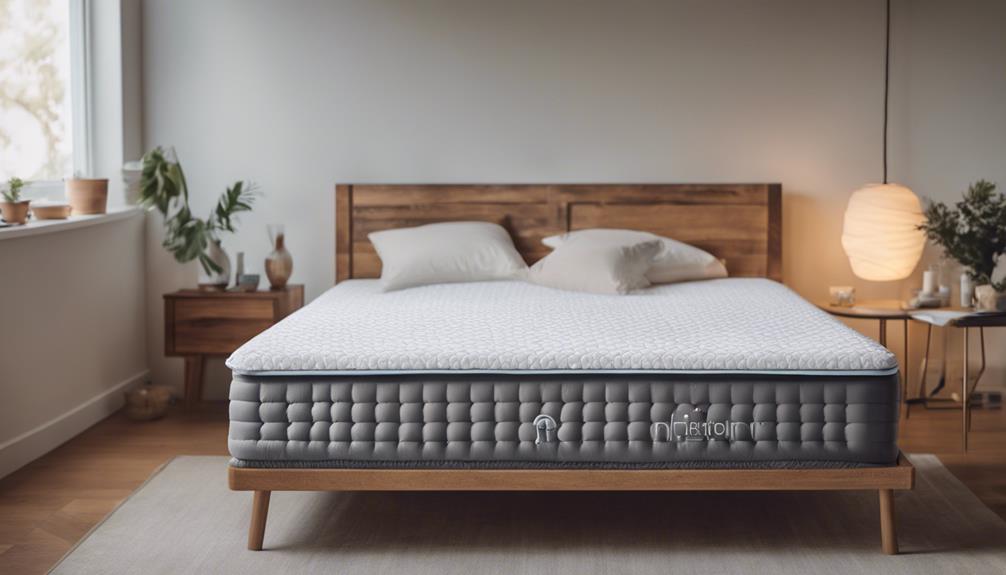
We frequently find that heated mattress pads are compatible with Nectar mattresses, offering additional warmth and comfort.
The memory foam construction of Nectar mattresses can benefit from the gentle heat provided by a heated mattress pad, helping to alleviate muscle aches and improve overall sleep quality.
When considering using an electric blanket on your Nectar mattress, it's crucial to prioritize safety.
Following safety tips such as proper ventilation and closely monitoring temperature settings can guarantee a cozy and secure sleeping environment.
Importance of Safety Features in Heated Mattress Pads
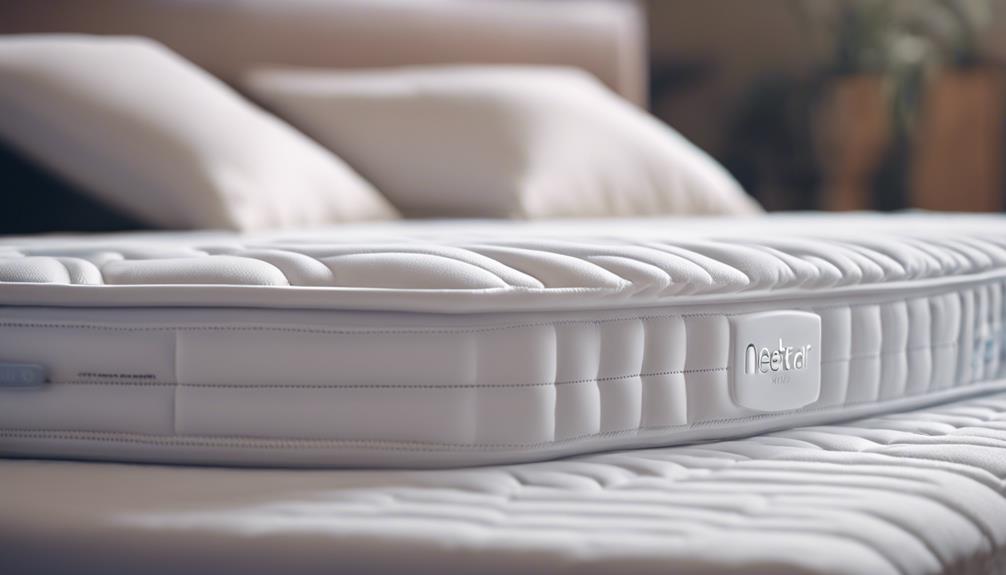
To guarantee the longevity and performance of a Nectar mattress when using a heated mattress pad, prioritizing safety features becomes essential. Memory foam mattresses like Nectar are susceptible to damage from overheating, making safety features critical for maintaining their quality. Direct heat application can lead to foam degradation, affecting the overall comfort and support provided by the mattress over time. Safety features in heated mattress pads play an important role in preventing overheating, which can cause premature foam failure and impact the mattress's lifespan.
Investing in a heated mattress pad with adequate safety features, such as temperature control settings and overheating protection, is necessary to protect your Nectar mattress. Additionally, using a mattress protector can help mitigate the risks associated with direct heat contact, providing an extra layer of defense against potential damage. By prioritizing safety features and following guidelines when using a heated mattress pad on a memory foam mattress like Nectar, you can ensure the continued performance and comfort of your bed for years to come.
Benefits of Using a Heated Mattress Pad on a Nectar Mattress
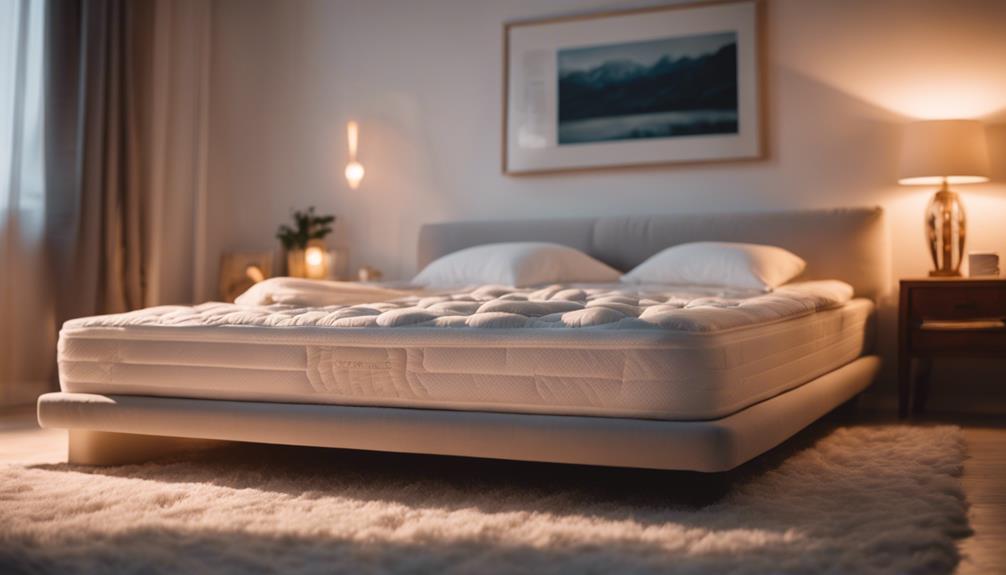
Using a heated mattress pad on a Nectar mattress can enhance comfort and warmth during colder nights. Here are three benefits of incorporating a heated mattress pad into your sleep routine:
- Personalized Comfort: By adjusting the temperature settings on the heated mattress pad, you can create a cozy environment that suits your preferences. This personalized warmth can help you relax and unwind after a long day, promoting better sleep on your Nectar mattress.
- Muscle Relaxation: The gentle heat provided by the mattress pad can help soothe muscle aches and tension, allowing you to wake up feeling refreshed and rejuvenated. This added comfort can contribute to a more restful night's sleep on your memory foam Nectar mattress.
- Efficient Heating: Unlike traditional electric blankets, a heated mattress pad offers even distribution of warmth, ensuring that your entire body receives the benefits of the added heat. This efficient heating method can help you make the most of your comfortable bed by maximizing the use of your body heat alongside the pad's warmth.
Tips for Enhancing Sleeping Experience With Heated Mattress Pads on Nectar Mattresses
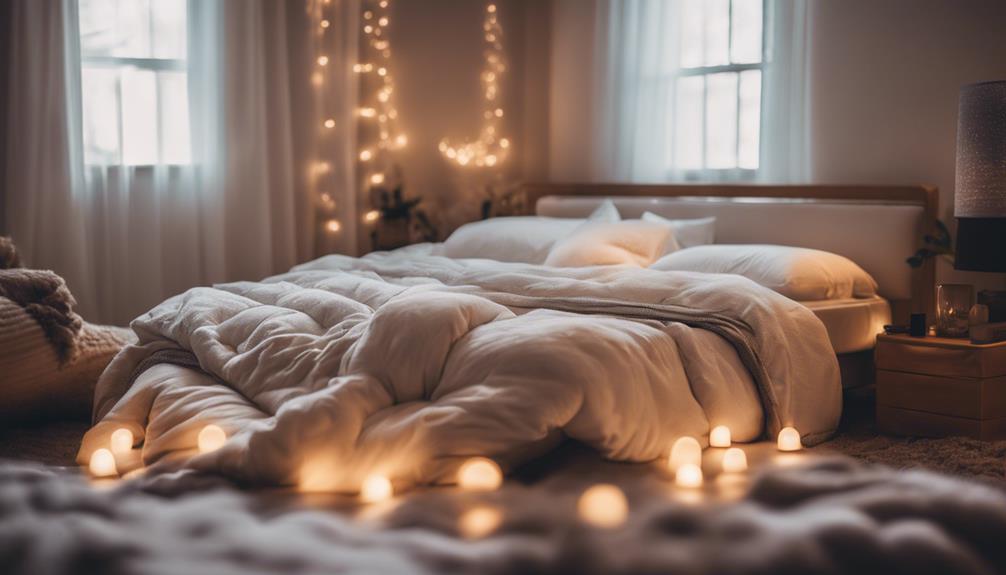
Enhance your sleeping experience on a Nectar mattress with these practical tips for using heated mattress pads. When incorporating an electric blanket on your Nectar mattress, remember to prioritize safety. Guarantee the heated mattress pad is evenly placed over the memory foam mattress to avoid overheating and allow for proper ventilation. By following safety tips and controlling the temperature settings, you can create a cozy environment without compromising your safety.
If you suffer from back pain, a heated mattress pad on your Nectar mattress can provide relief by soothing your muscles and joints. The warmth generated by the pad can help alleviate discomfort, promoting a more restful night's sleep. By combining the comfort of memory foam with the added warmth from the heated pad, you can create a luxurious sleep haven right in your own bedroom. So, snuggle up, relax, and let the heated mattress pad enhance your Nectar mattress experience.
Maintenance and Care for Heated Mattress Pads on Nectar Mattresses

Regular maintenance is essential for prolonging the lifespan of heated mattress pads used on Nectar mattresses. When caring for your electric blanket on a memory foam mattress, consider the following safety tips for using and maintaining it:
- Use a Mattress Protector: Investing in a quality mattress protector can help shield your Nectar mattress from any potential damage caused by the heated pad. It acts as a barrier against sweat, skin oils, and other substances that could seep through and affect the memory foam material.
- Follow Manufacturer Guidelines: Adhering to the manufacturer's instructions for your specific heated mattress pad model is vital. This ensures you're using it correctly and minimizing any risks that could harm your Nectar mattress over time.
- Regular Cleaning: Keep your electric blanket clean by following the cleaning recommendations provided. Regularly washing and maintaining the pad can help prevent any buildup of dirt or debris that might affect its performance and impact the mattress beneath it.
Frequently Asked Questions
Can I Use a Heated Mattress Pad on a Memory Foam Mattress?
Yes, you can use a heated mattress pad on a memory foam mattress, but it's important to proceed with caution. Direct heat can degrade memory foam over time, causing premature failure and voiding warranties. Sweat and skin oils can exacerbate this issue.
Additionally, memory foam releases dangerous gases when exposed to fire. To preserve your mattress, consider using a protective barrier or lower heat settings on the pad.
Do You Put a Mattress Pad on a Nectar Mattress?
Yes, placing a mattress pad on a Nectar mattress is a smart choice. It shields your mattress from spills, stains, and general wear, extending its lifespan.
A well-fitted pad guarantees a cozy and secure setup. You can also tailor the feel of your mattress with different pad materials. Enhance comfort by adding softness or adjust support with firmer options.
Can I Use a Heated Mattress Pad on a Tempur Pedic?
Using a heated mattress pad on a Tempur-Pedic bed isn't recommended. Direct heat might harm the memory foam, affecting its comfort and durability. It could even void the warranty.
Tempur-Pedic mattresses are designed to mold to your body's warmth, so extra heat isn't necessary. Preserving your mattress means exploring other ways to stay cozy.
Let's guarantee your Tempur-Pedic stays comfy for years to come!
Can You Put a Heated Blanket on a Memory Foam Mattress?
Yes, you can safely use a heated blanket on a memory foam mattress like Nectar. To guarantee safety and comfort, always place a sheet as a protective barrier between the electric blanket and the mattress.
Starting at a low temperature and gradually increasing it's ideal. Utilize the timer function for added peace of mind. Remember, indirect contact is key to a cozy and safe sleep experience on your memory foam mattress.
Conclusion
To sum up, utilizing a heated mattress pad on a Nectar mattress can enhance your sleeping experience by providing warmth and comfort. It's crucial to follow safety guidelines and guarantee compatibility to avoid any risks.
With the right features and maintenance, a heated mattress pad can be a valuable addition to your sleep routine. So, don't let the cold weather get you down – cozy up with a heated mattress pad and enjoy a restful night's sleep on your Nectar mattress!
Mattress Pads
Do You Use a Mattress Protector With a Mattress Pad
Create a double defense for your mattress with a protector and pad – discover how this duo elevates your sleep experience.
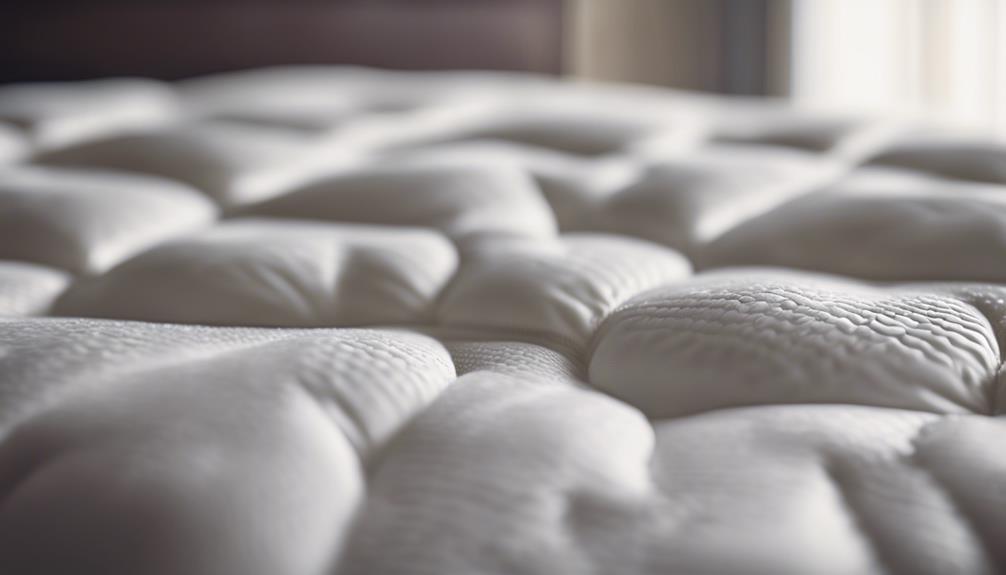
Yes, it’s a fantastic idea to utilize a mattress protector with a mattress pad. The protector defends against spills, stains, and allergens, ultimately prolonging the lifespan of the mattress. Concurrently, the pad adds an additional layer of comfort and support. Together, they provide enhanced protection while improving your sleep quality. This dual-layer method safeguards against wear and tear, moisture, and ensures a cozy sleeping surface. This combination not only extends the lifespan of your mattress but also enhances your overall sleeping experience. Therefore, consider combining them for optimal protection and comfort.
Key Takeaways
- Using both offers enhanced protection and comfort for your mattress.
- A mattress protector shields against spills, stains, and allergens.
- A mattress pad enhances comfort and support with an extra layer of cushioning.
- The combination prolongs mattress lifespan and enhances the sleeping experience.
- Waterproof protection from the protector complements the plush cushioning of the pad.
Key Differences Between Protector and Pad
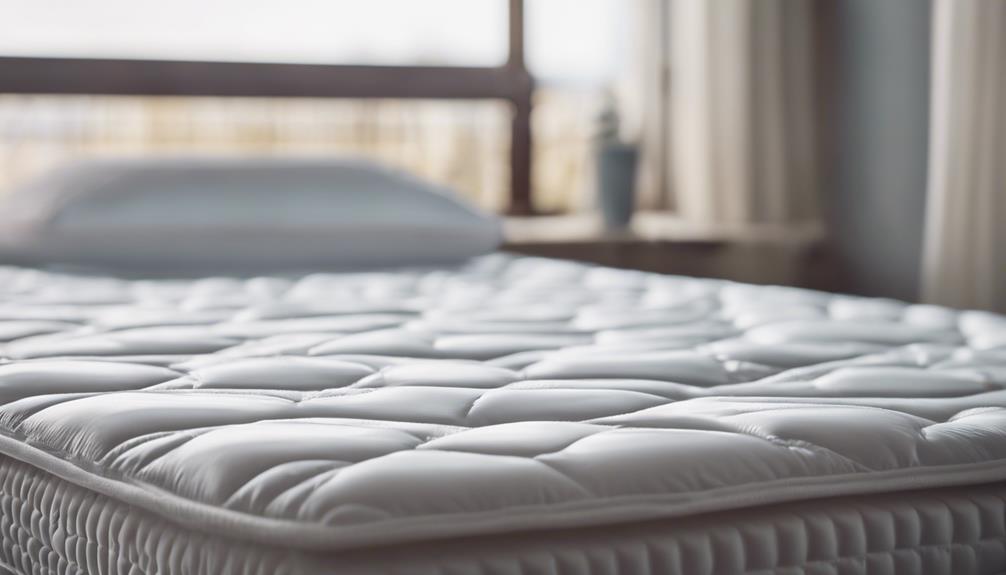
When comparing a mattress protector to a mattress pad, the key differences lie in their primary functions and design features.
A mattress protector serves as a shield against spills, stains, and allergens, offering waterproof protection to keep your mattress in pristine condition. The protector's design often includes elastic edges to guarantee a secure fit around the mattress, effectively safeguarding it from any potential harm.
On the other hand, a mattress pad focuses on enhancing comfort by adding an extra layer of softness and support to the bed. Pads are thicker than protectors and may slightly alter the feel of the mattress, providing a cozy and plush sleeping surface.
While protectors prioritize the longevity of the mattress through protection, pads are geared towards improving the overall comfort level of your sleep environment. Understanding these distinctions can help you make an informed decision based on your specific needs, whether it be safeguarding your mattress from spills and allergens or enhancing your sleep experience with added comfort.
Benefits of Using a Mattress Protector
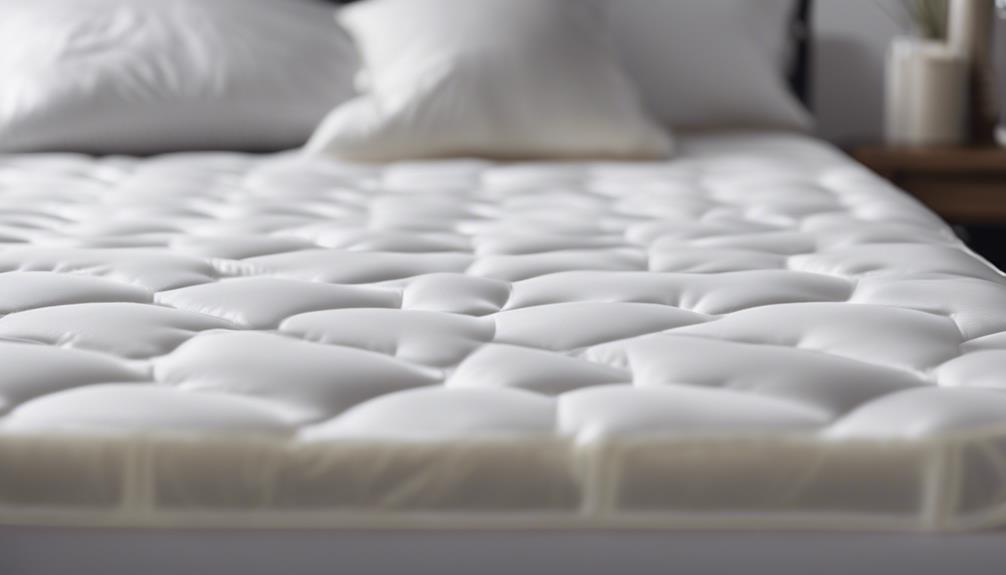
Using a mattress protector offers numerous advantages, such as safeguarding against spills and providing an effective barrier against allergens. These protectors can help maintain mattress cleanliness and hygiene, ensuring a healthier sleep environment.
Additionally, waterproof protectors extend the lifespan of your mattress by preventing damage from liquids.
Protection Against Spills
Investing in a mattress protector provides essential protection against spills, safeguarding your mattress and guaranteeing its longevity. A waterproof mattress protector acts as a shield, preventing liquids from seeping into the mattress and causing stains, odors, or damage over time.
By using a protector, you can keep your mattress clean and hygienic, preserving its quality and extending its lifespan. This is especially beneficial for households with kids, pets, or individuals prone to accidents.
With a mattress protector in place, you can protect your mattress from costly damage and the need for premature replacement, saving you money in the long run. Secure your mattress stays in top condition by investing in a quality protector today.
Allergen Barrier Properties
Enhancing sleep quality for allergy sufferers, mattress protectors serve as a shield against allergens like dust mites, molds, and pet dander. These protectors act as a barrier, preventing allergens from penetrating the mattress and reducing the risk of allergic reactions and respiratory issues.
Waterproof mattress protectors also guard against liquid spills, which can trigger mold growth and worsen allergies. By creating a thorough protective barrier, mattress protectors contribute to a cleaner sleep environment, helping allergy sufferers rest more comfortably.
When combined with a mattress pad, these protectors offer a complete solution for both comfort and allergen protection, ensuring a restful and allergy-free sleep experience. Using a mattress protector is a practical way to promote a healthier and more comfortable sleep environment.
Advantages of Using a Mattress Pad
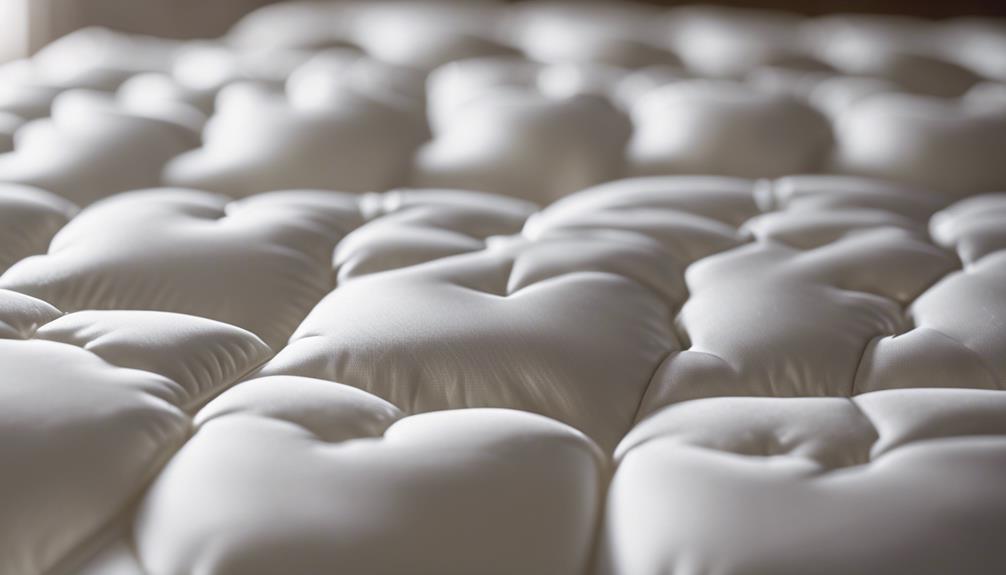
Adding a mattress pad to your bed can greatly enhance your sleeping experience.
It provides an extra layer of comfort and support, making your nights more restful.
Additionally, a mattress pad can help prolong the lifespan of your mattress, saving you money in the long run.
Enhanced Comfort Layer
We find that incorporating a mattress pad onto your bed can introduce an extra layer of comfort and support, enhancing your overall sleep experience. The mattress pad acts as a comfort layer, providing additional cushioning and support without drastically altering the feel or firmness of your mattress. This added plushness can be especially beneficial for older mattresses that may have lost some of their original cushioning.
Moreover, the mattress pad helps in extending the lifespan of your mattress by acting as a protective barrier against wear and tear. Additionally, it can reduce noise, creating a quieter sleep environment by dampening any sounds that may arise from using a mattress protector.
Increased Mattress Longevity
By acting as a protective barrier against wear and tear, a mattress pad can greatly increase the longevity of your mattress. This extra layer of cushioning not only shields your mattress from spills, stains, and body oils that can cause damage but also helps in maintaining the structural integrity over time. The mattress pad serves as a defense against dust mites and allergens, promoting a cleaner and healthier sleep environment. By reducing the impact of everyday use, such as pressure points and indentations, the mattress pad prolongs the lifespan of your mattress. Investing in a quality mattress pad proves to be a cost-effective measure, potentially saving you money in the long run by delaying the need for a premature mattress replacement.
| Benefits of Using a Mattress Pad |
|---|
| Protective Barrier against Wear and Tear |
| Extra Layer of Cushioning |
| Shields from Spills and Stains |
| Guards against Dust Mites and Allergens |
| Maintains Structural Integrity |
How to Choose Between Protector and Pad
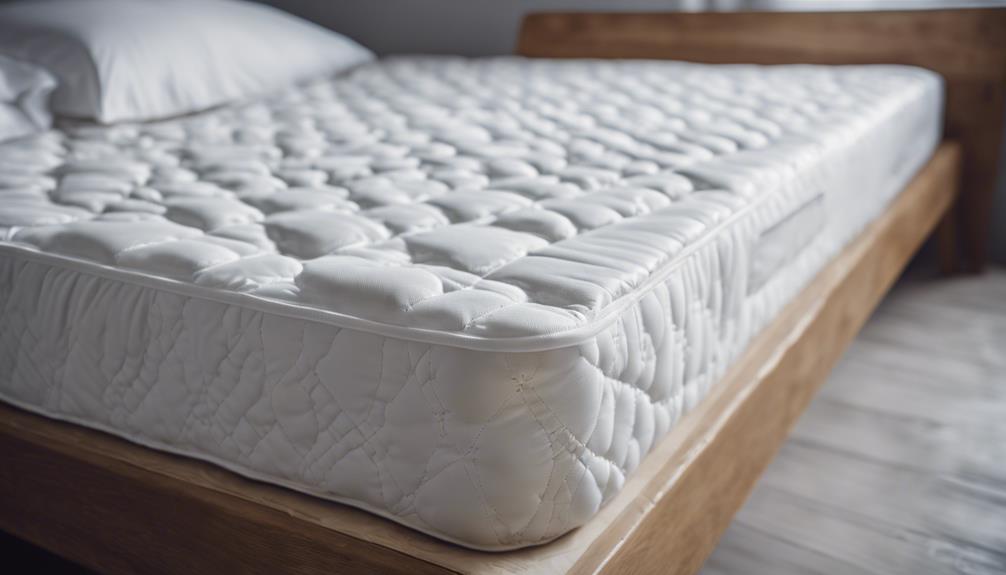
When deciding between a mattress protector and a mattress pad, it's important to assess your specific needs and preferences for your bed.
If protection against spills, stains, allergens, and bed bugs is your priority, a mattress protector is the way to go. On the other hand, if you seek to enhance the softness and cushioning of your mattress, a mattress pad may be more suitable for you.
Consider the overall feel you desire; mattress protectors focus on protection without altering the feel of your bed, whereas mattress pads add a layer of plushness.
Budget is also vital; mattress protectors are generally more affordable than mattress pads, so factor this into your decision.
Additionally, think about the lifespan of your mattress; a mattress protector can help extend its longevity by providing a protective barrier, especially if you have a new mattress that you want to maintain in top condition.
Can You Use Both Together?

Using both a mattress protector and a mattress pad together can offer enhanced protection and comfort for your bed. This dual-layer approach provides a thorough shield against spills, stains, allergens, and general wear and tear. The mattress protector acts as a barrier, safeguarding your mattress from moisture and allergens, while the mattress pad adds an extra level of cushioning for increased comfort. By combining these two accessories, you create a powerful defense system that helps prolong the lifespan of your mattress greatly.
When considering using both a mattress protector and a mattress pad, it's crucial to choose a waterproof protector to prevent liquid damage and a plush pad for added comfort. This combination not only ensures your mattress remains free from spills and stains but also enhances your sleeping experience. The protector and pad work hand in hand to provide a balance of protection and comfort, making your bed a cozy haven while keeping it safe from potential harm.
Considerations for Protector Vs. Pad
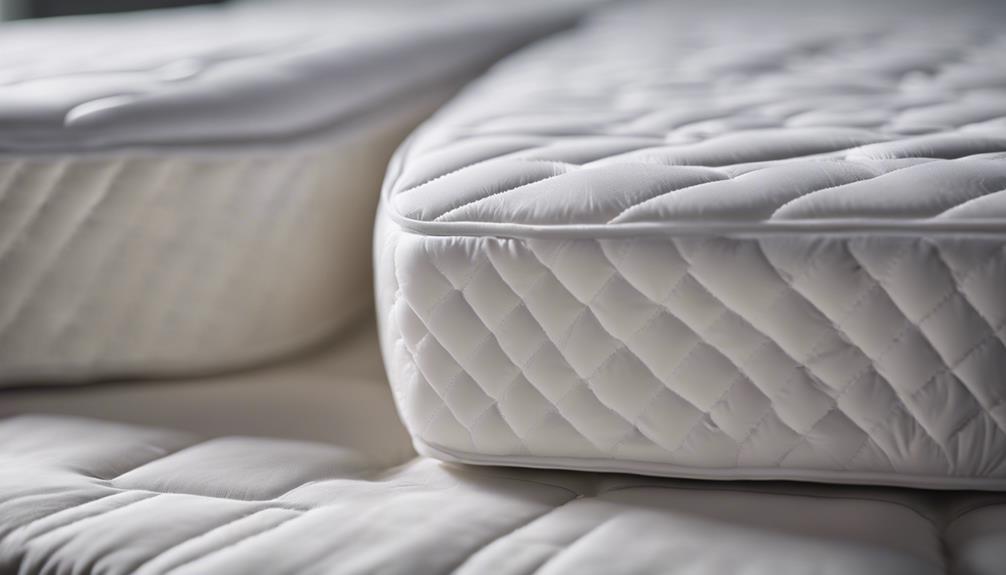
When evaluating a mattress protector versus a mattress pad, it's important to assess the specific advantages each provides for your bed. A mattress protector acts as a shield against moisture, stains, allergens, and bed bugs, offering thorough protection for your mattress.
On the other hand, a mattress pad focuses on comfort, adding a layer of plushness to enhance your sleep experience. Protectors are thinner and prioritize safeguarding your mattress, while pads are thicker, providing extra cushioning for added comfort.
The decision between a protector and a pad depends on whether you prioritize mattress protection or comfort. However, using both a mattress protector and pad can create a combination that offers the best of both worlds – comfort and protection.
Making the Right Choice for You
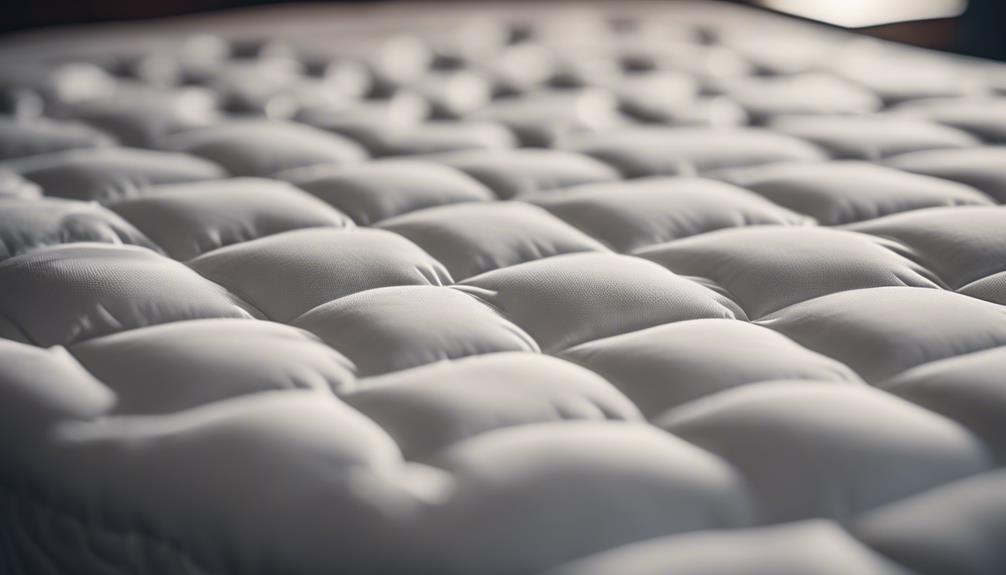
To make the right choice between a mattress protector and a mattress pad, assess your specific needs for comfort, protection, and overall mattress care. If you prioritize safeguarding your mattress from spills, stains, allergens, and bed bugs, a mattress protector might be the ideal choice. These protectors often come with waterproof features that shield your mattress from liquid damage and unwanted intruders.
On the other hand, if you seek to enhance comfort and add extra cushioning to your bed, a mattress pad could be more suitable. The combination of a mattress protector and pad can offer a balance of comfort and protection, extending the lifespan of your mattress by preventing wear and tear.
Consider how each option aligns with your requirements for a cozy sleep environment, protection against potential hazards, and the longevity of your mattress to make an informed decision that best suits your needs.
Frequently Asked Questions
Do You Need Both a Mattress Pad and Protector?
We find that using a mattress pad and protector can offer a range of benefits for your mattress.
While not essential, this combination can provide both comfort and protection.
Depending on your priorities, you may opt for a mattress pad to enhance comfort or a protector to shield against stains and allergens.
By choosing products like the SafeRest protector, you can enjoy the dual benefits of protection and added comfort.
It all boils down to your specific needs and preferences.
Should I Use a Mattress Protector With a Mattress Topper?
We believe using a mattress protector with a mattress topper is a wise choice. A protector shields against spills, stains, allergens, and even bed bugs, while a topper adds extra comfort and support.
By combining the two, you can prolong your mattress's lifespan and enjoy a cozy sleep environment. Waterproof protectors offer added security, while toppers focus on enhancing your comfort.
Prioritize mattress care, comfort, and protection to make an informed decision!
Does a Mattress Pad Go Over or Under a Mattress Cover?
We always place our mattress pad under the cover for added protection and comfort. This extra layer not only safeguards the mattress from spills and wear but also enhances the overall sleep experience.
What Do You Cover a Mattress Pad With?
We cover our mattress pad with a mattress protector to safeguard against spills, stains, dust mites, and allergens. This combination not only adds comfort and cushioning but also prolongs the mattress's cleanliness and lifespan.
Conclusion
To sum up, choosing between a mattress protector and a mattress pad is like picking the perfect toppings for your favorite pizza – each serves a different purpose but together they create the ultimate comfort experience.
Whether you prioritize protection or extra cushioning, both options offer unique benefits for a good night's sleep. So, don't be afraid to mix and match or choose one over the other – the key is finding what works best for your personal needs and preferences.
Mattress Pads
Does a Mattress Topper Go Under the Mattress Pad
Get ready for the ultimate bedding upgrade by discovering the surprising reason why a mattress topper should go under the mattress pad…
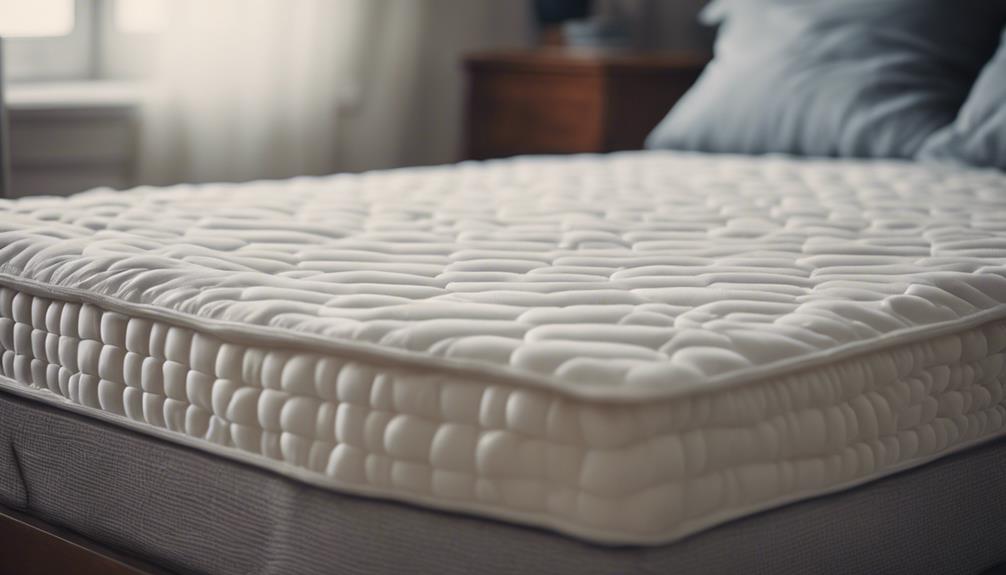
Placing a mattress topper under a mattress pad is essential for maximum comfort, support, and protection. This combination extends the life of your bedding, guards against sweat and spills, and creates a customized sleep surface. By placing the topper beneath the pad, you improve breathability and airflow, which helps prevent mold growth. This configuration also offers better pressure relief and contouring, resulting in a notable enhancement in sleep quality. It is important to remember that the order in which you place these bedding components impacts the overall comfort and functionality. Your sleep quality will greatly benefit from this correct arrangement. Additional tips are available to enhance your bedding setup.
Key Takeaways
- Placing mattress topper under mattress pad enhances protection and comfort.
- Memory foam topper under pad provides extra cushioning and support.
- Proper ventilation is essential; topper beneath pad may hinder airflow.
- Optimal arrangement improves sleep quality by balancing support and comfort.
- Misconception: Correct order is topper under pad for peak comfort and functionality.
Importance of Proper Placement

Placing the mattress topper under the mattress pad enhances protection against sweat, dust mites, and spills. This positioning not only safeguards the mattress but also contributes to our overall comfort during sleep. By ensuring the topper is correctly placed, it allows the mattress to better conform to our body shape, providing enhanced support where needed. Proper placement isn't only about protection but also about optimizing our sleep experience.
When arranging bedding items in the recommended order – mattress topper, optional pad, mattress protector, blanket, and pillows – we aren't only prioritizing comfort but also increasing the longevity of both the topper and the mattress. This setup caters to our individual sleeping preferences, ensuring that our specific needs are met for a restful night's sleep. Taking into account these preferences when placing the bedding items can make a significant difference in how well we rest each night.
Effects on Comfort and Support
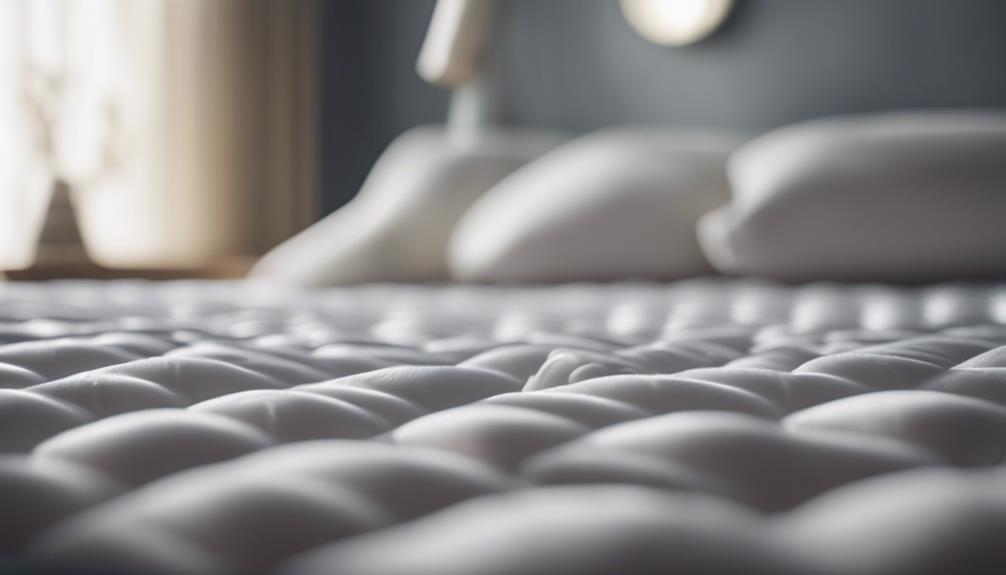
When considering the arrangement of bedding items, the position of a mattress topper beneath a mattress pad greatly impacts the comfort and support experienced during sleep. Placing a memory foam topper under the mattress pad enhances comfort by providing extra cushioning and support, allowing for better pressure relief and contouring. This setup not only adds a layer of cushioning but also offers customization, allowing you to tailor the feel of your bed to your preferences for a more restful sleep experience. Additionally, the topper acts as a protective barrier, prolonging the lifespan of both the topper and the mattress pad. By creating this luxurious and supportive sleep surface, the mattress topper under the mattress pad elevates relaxation and sleep quality significantly.
| Category | Description | Benefits |
|---|---|---|
| Comfort | Extra cushioning and support | Enhanced comfort |
| Support | Better pressure relief | Improved support |
| Customization | Tailoring bed feel | Personalized sleep |
Airflow and Breathability Considerations
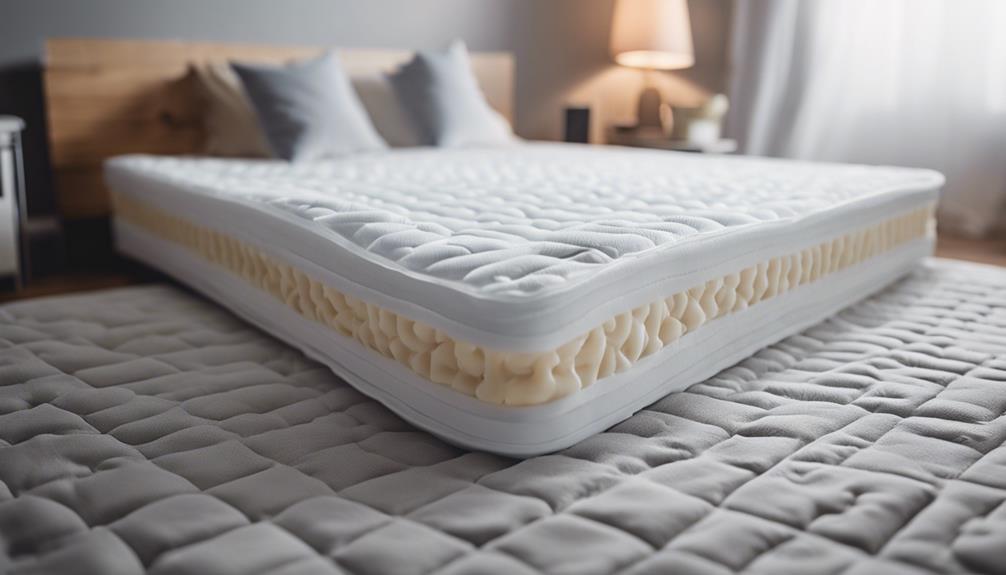
Considering airflow and breathability when arranging bedding is crucial for maintaining comfort and preventing potential issues like mold growth. The positioning of a mattress topper beneath a mattress pad can impact ventilation and comfort levels. Placing a mattress topper under the mattress pad can hinder proper air circulation, leading to reduced breathability.
Memory foam toppers often come with a fabric cover that allows for airflow, promoting breathability. However, in humid environments, the lack of ventilation may create a breeding ground for mold on the topper. To prevent mold growth and enhance breathability, it's advisable to position the mattress topper above the mattress and below the fitted sheet.
This arrangement allows for better ventilation, maintaining comfort levels and preventing potential mold issues. Proper airflow is essential not only for comfort but also for the longevity of the mattress topper. By ensuring adequate ventilation and breathability, you can create a more comfortable and hygienic sleep environment.
Optimal Arrangement for Sleep Quality
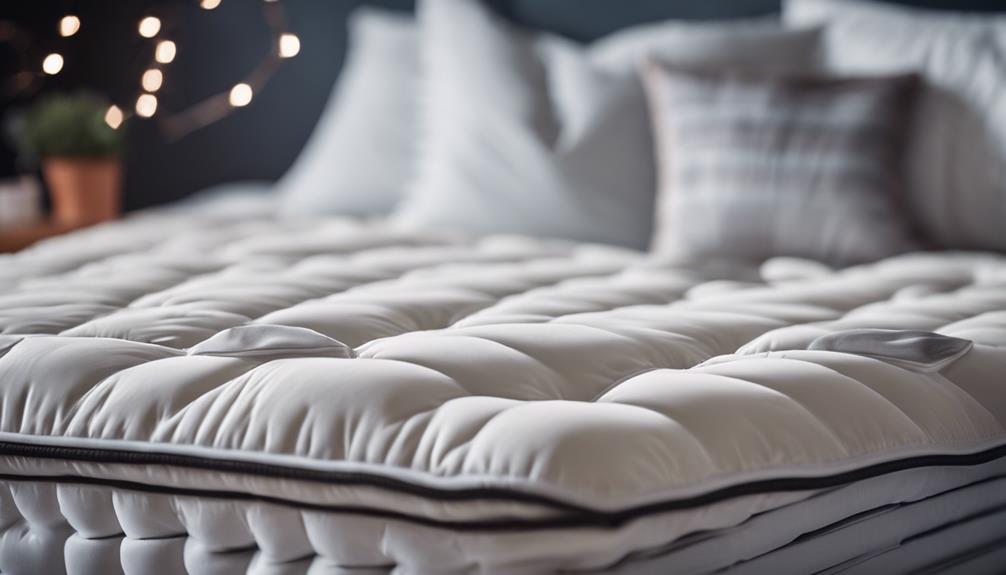
As we focus on optimizing sleep quality, the arrangement of bedding, specifically the interaction between the mattress topper and the mattress pad, plays a significant role in guaranteeing a comfortable and supportive rest experience. Placing the memory foam mattress topper under the mattress pad can enhance comfort and support, creating a personalized sleep surface. The mattress topper acts as the primary layer for adjusting firmness levels and providing extra cushioning for pressure point relief. On top of this, the mattress pad adds an additional protective layer against spills, dust, and general wear and tear, promoting mattress longevity.
This strategic layering not only enhances comfort but also balances the need for support and protection. By having the mattress topper under the mattress pad, the topper conforms better to the body while the pad offers additional protection, creating a harmonious blend of comfort and mattress preservation. This ideal arrangement not only enhances the sleep experience but also ensures the mattress's longevity, making it a win-win for both comfort and practicality.
Common Misconceptions and Clarifications
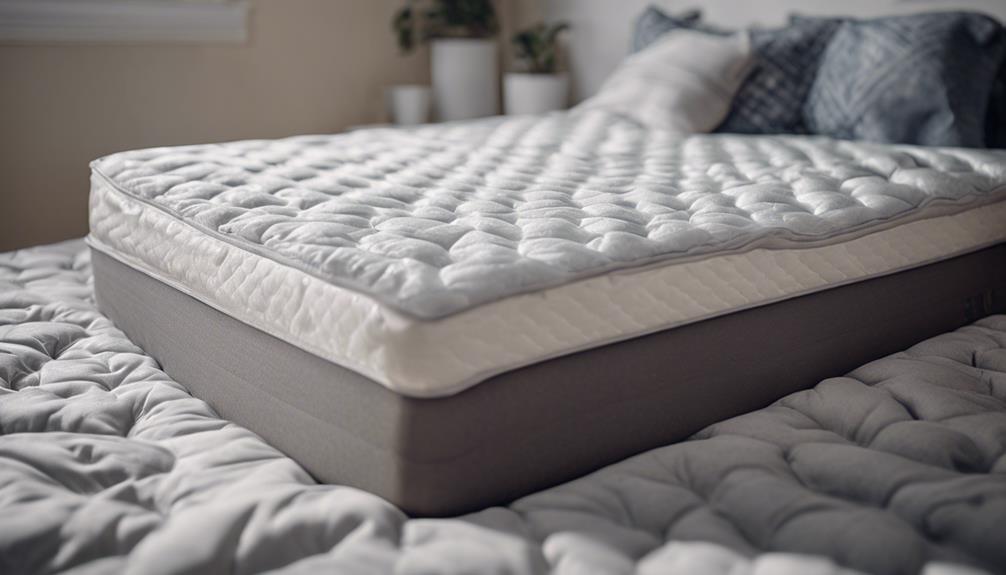
Our research dispels misunderstandings about the placement of a mattress topper in relation to a mattress pad. It is commonly thought that the mattress topper should rest on top of the mattress pad; however, the correct order is quite the opposite. Placing the mattress topper beneath the mattress pad is essential for maximizing comfort and support levels while sleeping. This arrangement allows the mattress topper to mold to the body, providing cushioning, while the mattress pad adds an extra layer of softness and protection.
To illustrate the correct layering of bedding items, consider the following table:
| Bedding Item | Correct Order |
|---|---|
| Mattress Topper | 1st |
| Mattress Pad | 2nd |
| Protector | 3rd |
| Blanket | 4th |
| Pillows | 5th |
Ensuring that the mattress topper is positioned under the mattress pad is fundamental for achieving peak comfort and functionality in your bedding setup.
Frequently Asked Questions
Does a Mattress Topper Go Under or Over a Mattress Cover?
When deciding whether a mattress topper goes under or over a mattress cover, we recommend placing the topper under the cover for maximum comfort and support.
This arrangement protects the topper from wear and tear while enhancing your overall sleeping experience.
By layering the topper under the cover, you can customize the feel and support of your bed to suit your preferences.
This setup guarantees a cozy and restful night's sleep.
Do I Need Both a Mattress Topper and a Pad?
Rest assured! A mattress topper can enhance comfort, while a mattress pad protects against spills and stains. Both work together for a balanced sleep experience.
Placing the topper on the mattress and the pad on top can optimize comfort and protection. This duo not only customizes your sleep but also keeps your mattress clean. It's a practical solution for comfort and maintenance needs.
Does a Mattress Topper Go Under the Bed Sheet?
Yes, a mattress topper typically goes under the fitted bed sheet for direct body contact, ensuring ideal comfort and support during sleep.
Placing the topper under the sheet creates a cozy barrier between the body and the mattress topper. Adding a mattress pad or protector on top can enhance durability and cleanliness.
Proper layering with the bed sheet on top of the topper maintains a comfortable and hygienic sleep environment for us.
Can You Put a Mattress Pad on Top of Memory Foam?
Yes, you can place a mattress pad on top of memory foam, but it may alter the feel and benefits of the memory foam layer. Memory foam requires contouring for best support, which might be impacted by the pad.
The combination could affect heat retention and result in a softer feel with reduced pressure relief. Consider personal comfort needs when deciding whether to use a mattress pad on memory foam.
Conclusion
To sum up, incorporating a mattress topper beneath a mattress pad is crucial for achieving ideal comfort and support while also enhancing airflow and breathability.
By following this straightforward yet efficient arrangement, you can guarantee a better night's sleep that feels like floating on a cloud.
So, don't underestimate the power of proper bedding placement – your body will thank you for it!
-
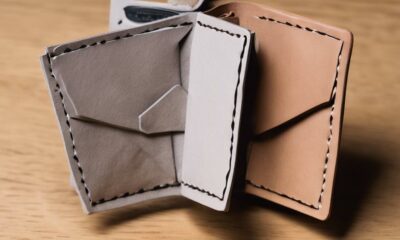
 Vetted6 months ago
Vetted6 months ago14 Best Personalized Father's Day Gifts for Your Husband – Show Him You Care
-

 Alfresco5 months ago
Alfresco5 months agoAlfresco Stacker Doors: Seamless Indoor-Outdoor Living!
-
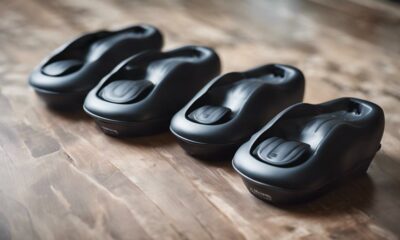
 Vetted7 months ago
Vetted7 months ago15 Best EMS Foot Massagers for Neuropathy to Soothe Your Feet
-

 Craft and Textiles7 months ago
Craft and Textiles7 months ago15 Best Places to Buy Appliances for Your Home – Top Retailers Reviewed
-

 Tableware and Dining Accessories7 months ago
Tableware and Dining Accessories7 months agoWhat Is the Meaning of the Word Tableware
-
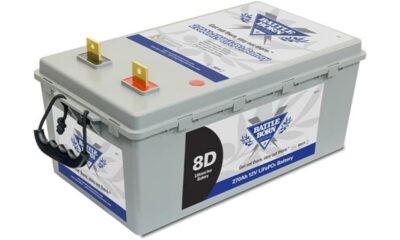
 Vetted5 months ago
Vetted5 months agoBattle Born Batteries Review: Reliable Power Solution
-
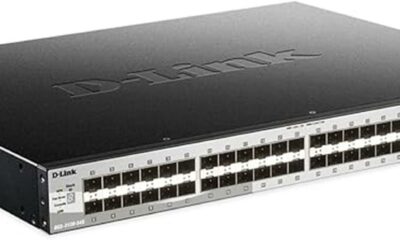
 Vetted5 months ago
Vetted5 months agoD-Link Switch Review: Lite Layer 3 Managed Networking
-

 Tableware and Dining Accessories7 months ago
Tableware and Dining Accessories7 months agoWhen Is Tableware on Sale at Hobby Lobby
